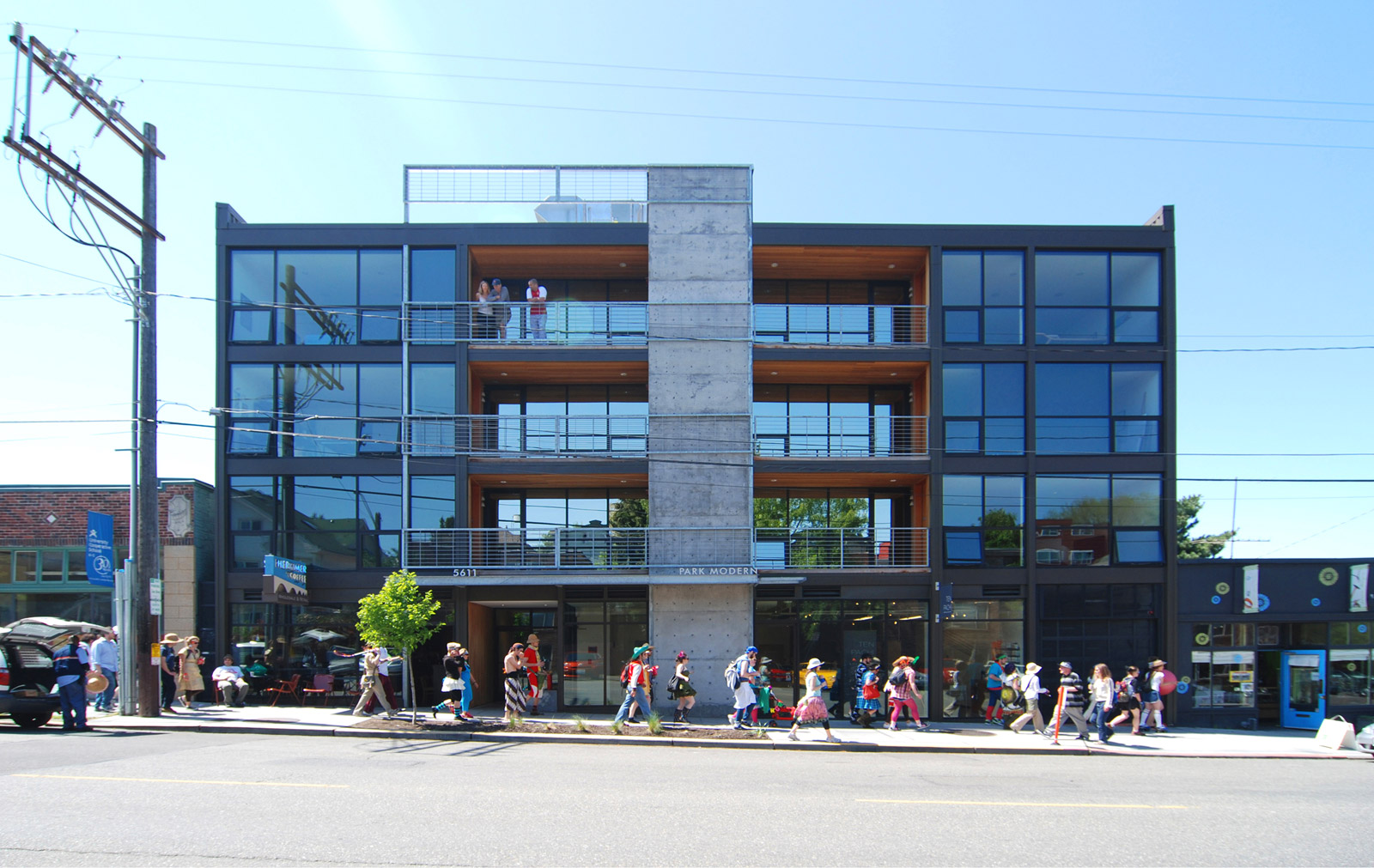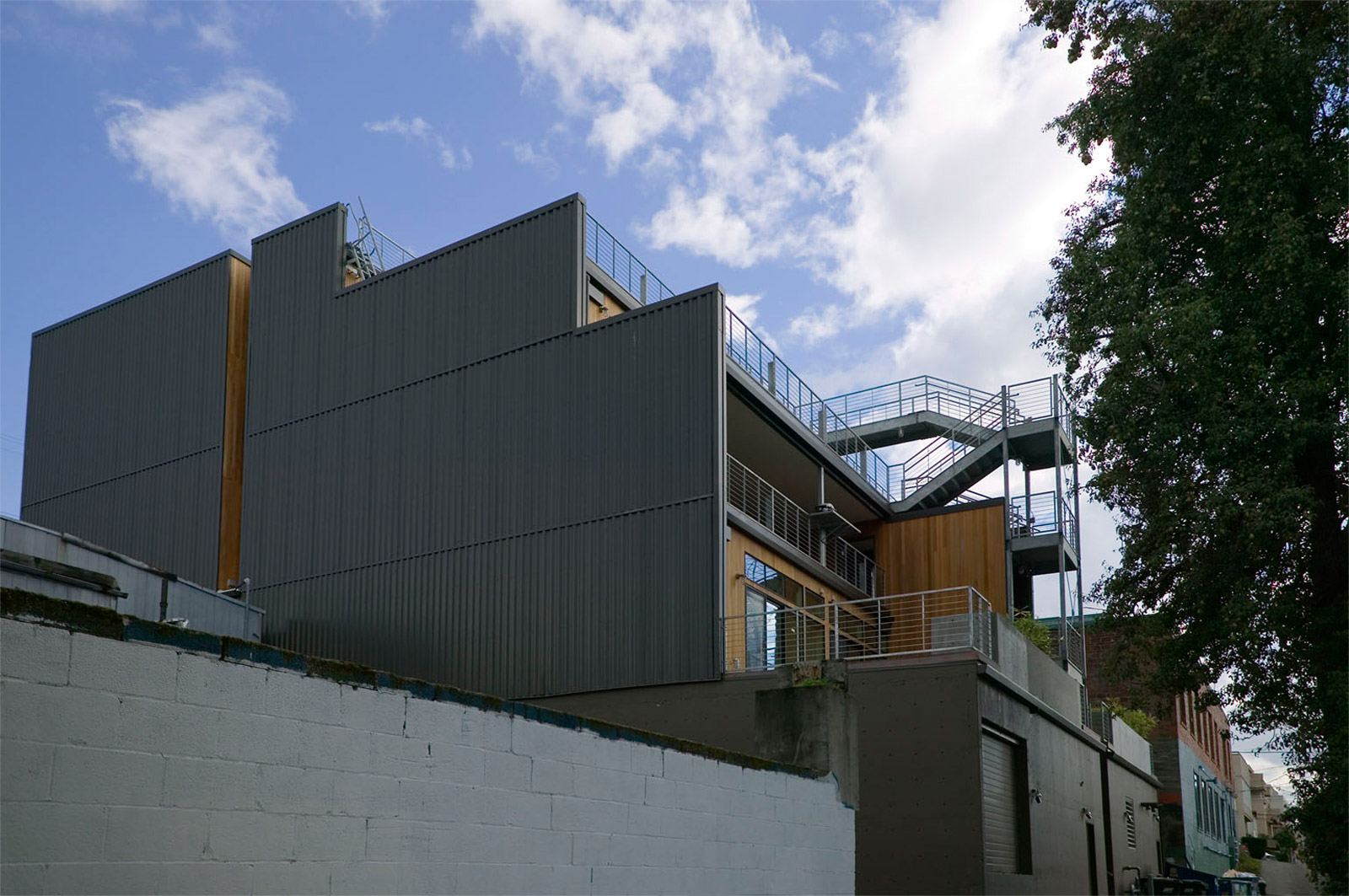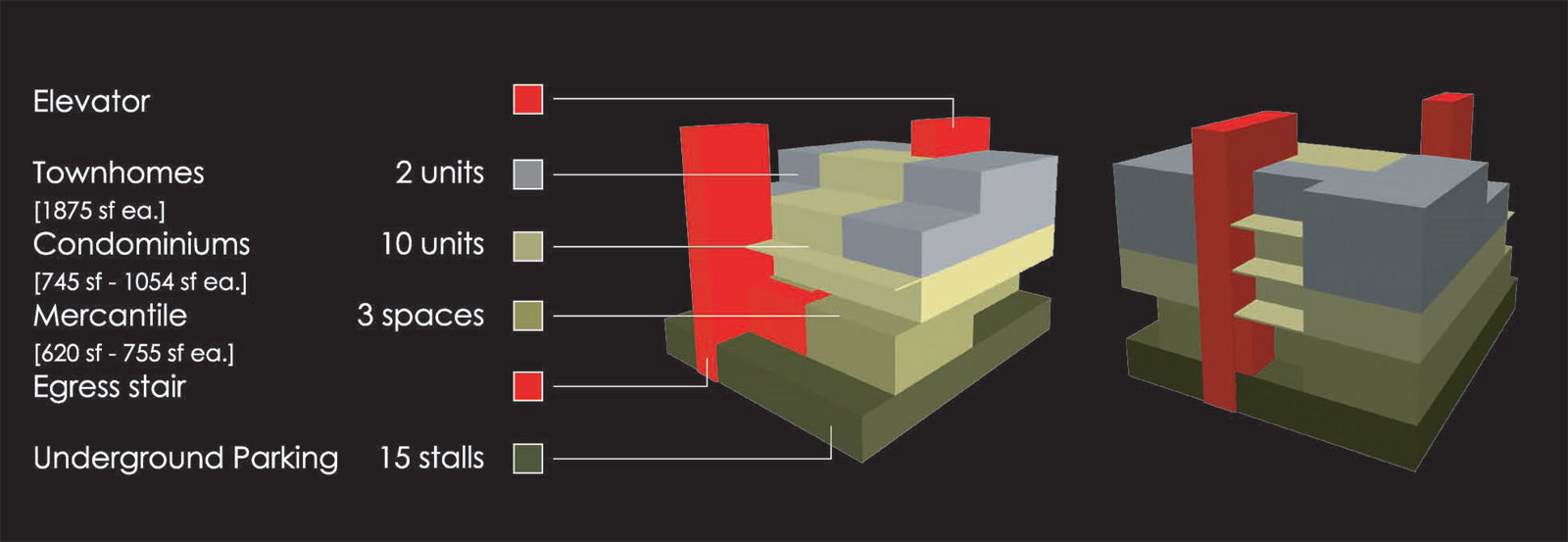
[Photo by BUILD LLC]
This post continues our two-part analysis of the development strategies we gleaned from the Park Modern building, which was completed in 2007. Part One was aimed at the planning and programming of the Park Modern and similar multi-family, mixed-use projects, while today’s will focus on the specifics of building design and regulatory agency systems.
6. Be a building code whisperer.
Building codes can be nebulous and complicated. At the same time, how the specifics of the code are interpreted have wide ranging impacts on the design, the construction, and the pricing of a project. Designing a multi-family, mixed-use building requires much more than a basic review and application of the building code. Standard prescriptions and template solutions not only overlook design opportunities, but they can be costly to the bottom line. An effective use of the building code involves scrutinizing key provisions, questioning the code when appropriate, and coordinating with plan reviewers to meet the intent of the code. Getting a large-scale building permitted also requires that an architectural team identify the exceptions and amendments to the building code.
One important code exception we discovered during the design process of the Park Modern building was the Single Exit Provision which allowed one egress stair to service the building, in addition to the elevator. This single stair in the back of the building meets all the code requirements based on floor occupancy and travel distance, and it has served the building well. The initial assumption for a project of our type and scale would surely lead a team into using two stair towers (thinking of potential exiting in event of fire). But, given the nature of building construction and systems in our era, complete with redundancies in fire protection, a single exit and careful planning can be just as effective.
Installing a second stair of this scale, as a cursory read of the building code would have prescribed, would have nearly torpedoed the project, both in experience (less light and air reaching the living units) and cost (we have yet to find a “buy one, get one free” stair tower vendor).

[Photo by Art Grice]
7. Find the champions at the building department.
It can often feel like the building department would prefer it if you simply rolled up your drawings, quit “bothering” them, and tucked the project into the archives. Despite this sentiment, there are heroes at the building department — individuals who are committed to good design, urbanism and community. Seek out these champions of good design and foster a mutually beneficial working relationship with them. Respecting what a good planner or building code reviewer brings to the table is an important part of the relationship. Trust may have to be earned over the course of several projects, but everyone recognizes good urban design when they see it.
During the schematic design phase of the Park Modern building, the Department of Planning and Development here in Seattle offered a two-day course on the interpretation of the newly adopted 2006 International Building Code and the Seattle amendments. We devoured this course. It was led by one of the outgoing senior planners who was a building code maven. Not only did he know the code backward and forward but he knew the strategies to meet code conformance and still arrive at great architectural solutions. He was passionate about intelligently and cleverly navigating the building code to produce exceptional architectural results, and this made a tremendous difference to the project. We used this course as a springboard to creating other DPD relationships which proved invaluable as we all, architects and DPD planners and reviewers, learned the intricacies and opportunities that the code offered.

[Image by BUILD LLC]
8. Design the narrative.
The design of a project’s narrative is every bit as important as the design of the building itself. Large-scale multi-family and mixed-use projects need to begin the social media buzz early, and the language for the promotional material and marketing launch should be in place long before a project’s completion. There’s most likely a wordsmith among a team of owners, developers, and architects, and this individual’s skill should be put to task on an inspiring narrative. Otherwise, a successful project risks devaluation in a competitive urban real estate market.
While we learned this lesson each step of the way with the Park Modern, we continually refined the marketing message to align with the clean living and simple modernism of the building’s design. The language evolved into a narrative just as much about lifestyle possibilities as the design of the project itself, and low-and-behold, it attracted a community of like-minded individuals.

[Photo by Chase Jarvis]
9. Conduct a marketing analysis.
Market analysis (who and how your project will likely serve) has started to drift away from the realm of the “dark arts” and migrate towards useful trends and data-driven patterns. Who are the likely people looking for what you offer? What is correct mix and type of units for the neighborhood and long term market? What is the value of the housing? What types of amenities will your building and the larger neighborhood respond to and support?
As we found out with the Park Modern project, finding the target audience(s) for the housing we created was more difficult than one might assume. There are groups and experts who can help with this, guiding a project to its optimal use and value. Many designers and developers have simply developed a good feel for this calculus based on the data and experience of successfully programmed projects. While we didn’t have many of these resources going into the Park Modern project, we had them by the time we completed it.

[Photo by Chase Jarvis]
10. Serve the project.
In addition to being designers, the most successful architects doing multi-family, mixed-use work have become service firms. This paradigm shift puts an architecture practice in the position of helping developer clients ensure that they are doing a project correctly. This holistic role may involve aspects ranging from what the potential value of living units might be, to anticipating concerns from the surrounding community. This business model is far greater than simply designing buildings, and it is the way of the future for firms that want to be doing exceptional work.
Because we were the architect, builder, and developer on the Park Modern project, we became intimately familiar with all of the challenges a developer needs to navigate. Simply put, everything was our problem to deal with, and we learned to wear a lot of hats. After an experience like this, it’s nearly impossible to put the blinders on and ignore all of the issues ancillary to the design and permitting of a building — it’s all part of the same equation. Having to tackle everything with a small team became a call-to-action for us that continues to benefit us on current and future projects.

[Image by BUILD LLC]
Cheers from Team BUILD





